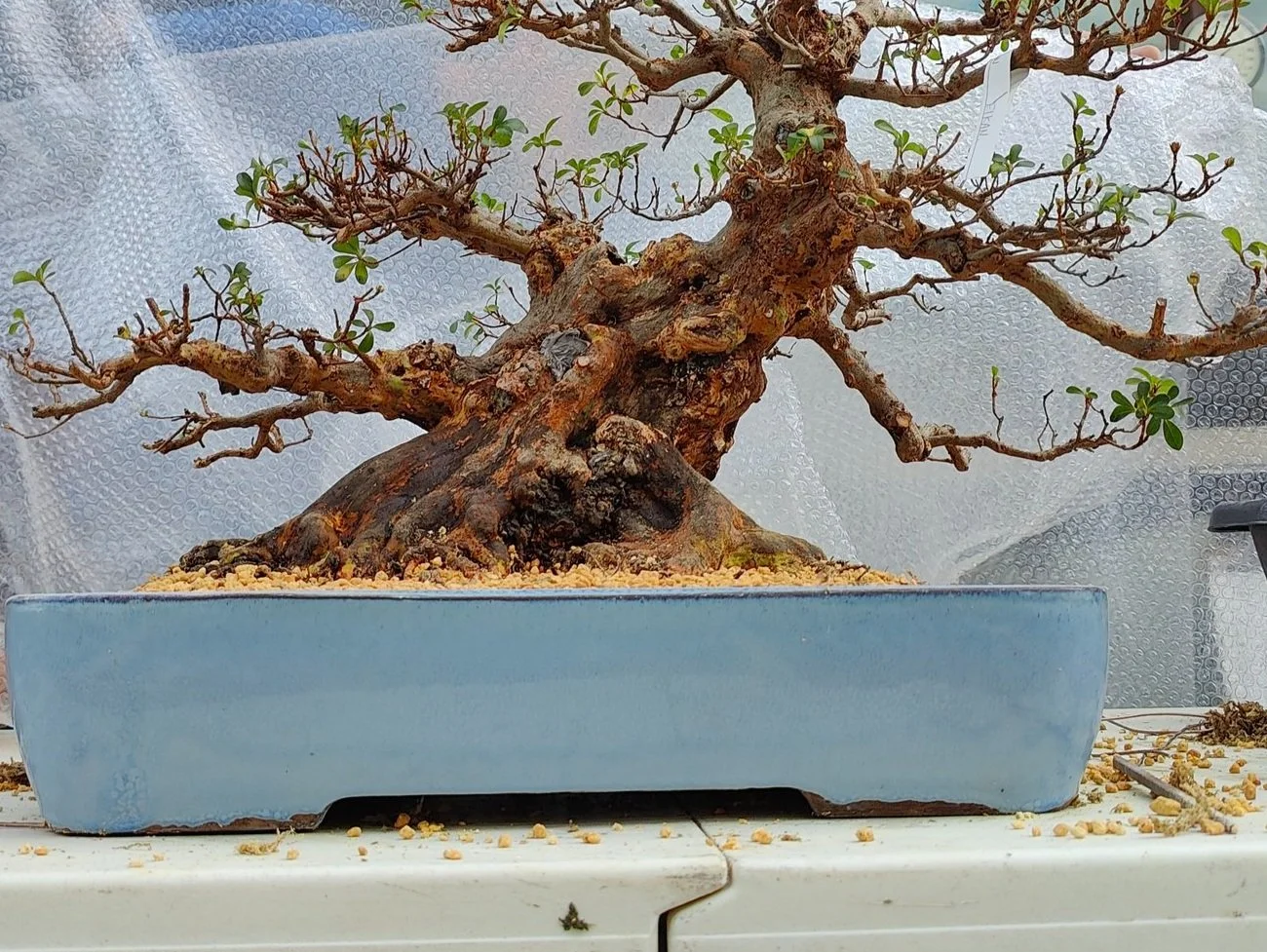WHAT IS A BONSAI?
BONSAI IS AN ART FORM:
盆栽 (pronounced “bone-sigh”) is made up of two kanji symbols - 盆 (bon) and 栽 (sai) - literally, “tree” and “pot / container”.
Simply put, bonsai is plant material, usually trees or shrubs, that are stylistically maintained in a container. The art of bonsai aims to invoke the “ideal” image trees in nature - whether a struggling pine on a mountainside that has been beaten down by the elements, an ancient deciduous tree with sweeping branches and a full canopy, or even forests that echo an absolute sense of place. In this way, bonsai is living sculpture - the intersection of art and horticulture.
THE MISCONCEPTIONS:
There’s no such thing a “bonsai species” of tree. Bonsai are genetically no different than their counterparts in nature.
Bonsai are not all “little pine trees” as has been popularized in modern media like the “Karate Kid” (actually Mr. Miyagi’s tree that you’re likely picturing was a juniper - not a pine!). There really are no limitations on what species can become bonsai, although there are species that are more suited to the art.
Bonsai are RARELY indoor plants!
As mentioned above, bonsai are genetically identical as trees in the ground. They have environmental requirements that cannot be met indoors in most cases. Most bonsai are grown outdoors, year-round. Generally, when bonsai are displayed either in exhibition or within the home, it is only for several days at a time.
Bonsai are not exclusively from Japan.
The concepts and techniques of bonsai can be applied universally to any species of tree / shrub and are not confined to Japanese species only (though they do have some killer ones).
HOW TO CARE FOR BONSAI
WATERING:
Watering is a daily ritual and the single most important skill in all of bonsai.
Don’t be intimidated - watering is easy to learn! Though, it takes years to master.
Your bonsai will certainly not need to be watered every single day of the year - BUT it does need to be checked on a daily basis. The learning curve of bonsai is steep, because it only takes one, maybe two - if you’re lucky - missed waterings before your bonsai is at death’s door. On the other hand, watering too frequently can slowly kill your bonsai over time.
That’s why it is imperative that you check on your bonsai daily, sometimes more often, and that you know what you’re looking for when you do.
Without getting into the weeds, water your bonsai when it’s unwatered, don’t water it when it’s watered.
UNWATERED
WATERED
REPOTTING:
When we repot our bonsai, the survival of the tree is never in question.
We never knowingly risk the survival of our bonsai when we repot properly. It is critical that we repot our trees at the proper time and with proper technique in order to ensure the health of the plant.
The choice of container, soil components, soil size, root removal, etc. are considerations that we make very carefully in Bonsai.
Why do we repot?
Repotting a bonsai is kind of like ‘spring cleaning’. First - it coincidentally usually occurs in the Spring. Second - it frees up new space in the container by cleaning out the old, potentially detrimental growing media and removing course, inefficient rootmass to make way for vigorous, fresh new roots to grow.
Bonsai is the act of growing and regrowing. Although we can confine these trees to a small container for a time, eventually they will fill their pots with roots and it will become difficult to maintain the health of the tree. We are constantly cultivating a rootball that will efficiently feed and support healthy, fine foliage. The roots that actually “feed” the tree are the fine - feeder - roots and roothairs.
At the same time, the soil is breaking down over time and can eventually become too compact for water and oxygen - which are vital to the tree’s health - to penetrate the growing medium. Periodically, we need to replace portions of the soil so that the tree has sufficient access to these resources.
When do we repot?
As mentioned above, 95 times out of 100, repotting is best done in the Spring season, as buds / needles / shoots are just beginning to swell and elongate.
The exceptions to the rule are tropicals, which are usually best repotting in the Summer while they are growing with extreme vigor, and bonsai that have serious health concerns and may require a repotting urgently, even “out-of-season”.
Borrowing from Heraclitus, “As above, so below”…and vice versa…
A beautiful, healthy, and fine rootmass is conducive to a beauty, healthy, fine canopy. Simple as.
PLACEMENT:
Every species has different sun requirements and cold / heat tolerance.
Most bonsai are ‘temperate’ species, meaning they require an outdoor environment. This need includes, but is not limited to, sun, shade, humidity, wind, cold - the list goes on. Trying to grow a temperate species indoors will result in failure at some point.
At Shibusa-en, we maintain very hardy species, delicate species, tropical species, etc. Some of our trees are left to freeze to the benches in the winter, others are protected in a greenhouse, others are brought indoors under grow-lights (tropicals). Picture to the right are two eastern larches laughing at our Saint Louis snow, still showing some green.
Knowing the needs of your tree - really, mimicking it’s natural environment - is very important to the longevity of plants in your care.









